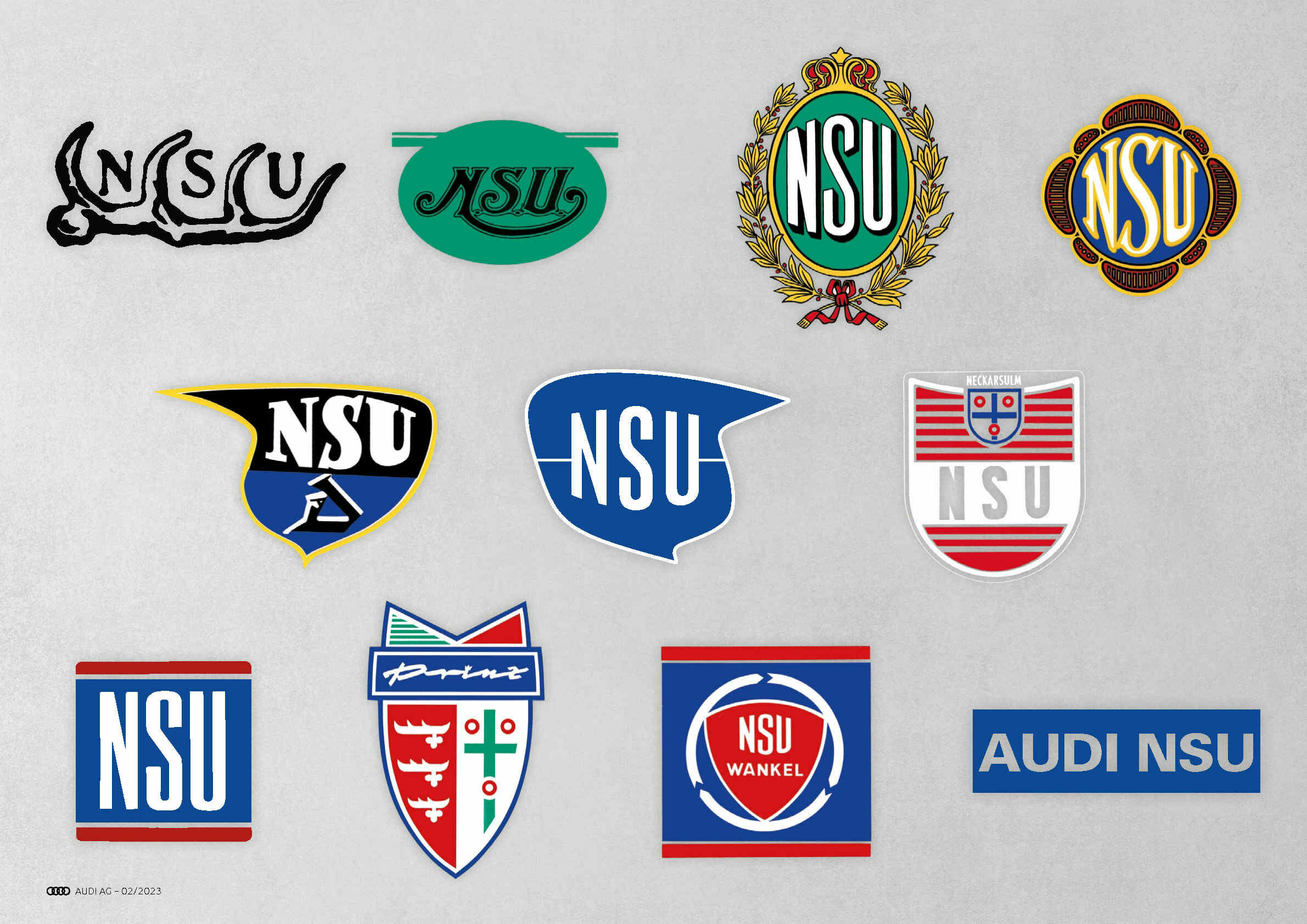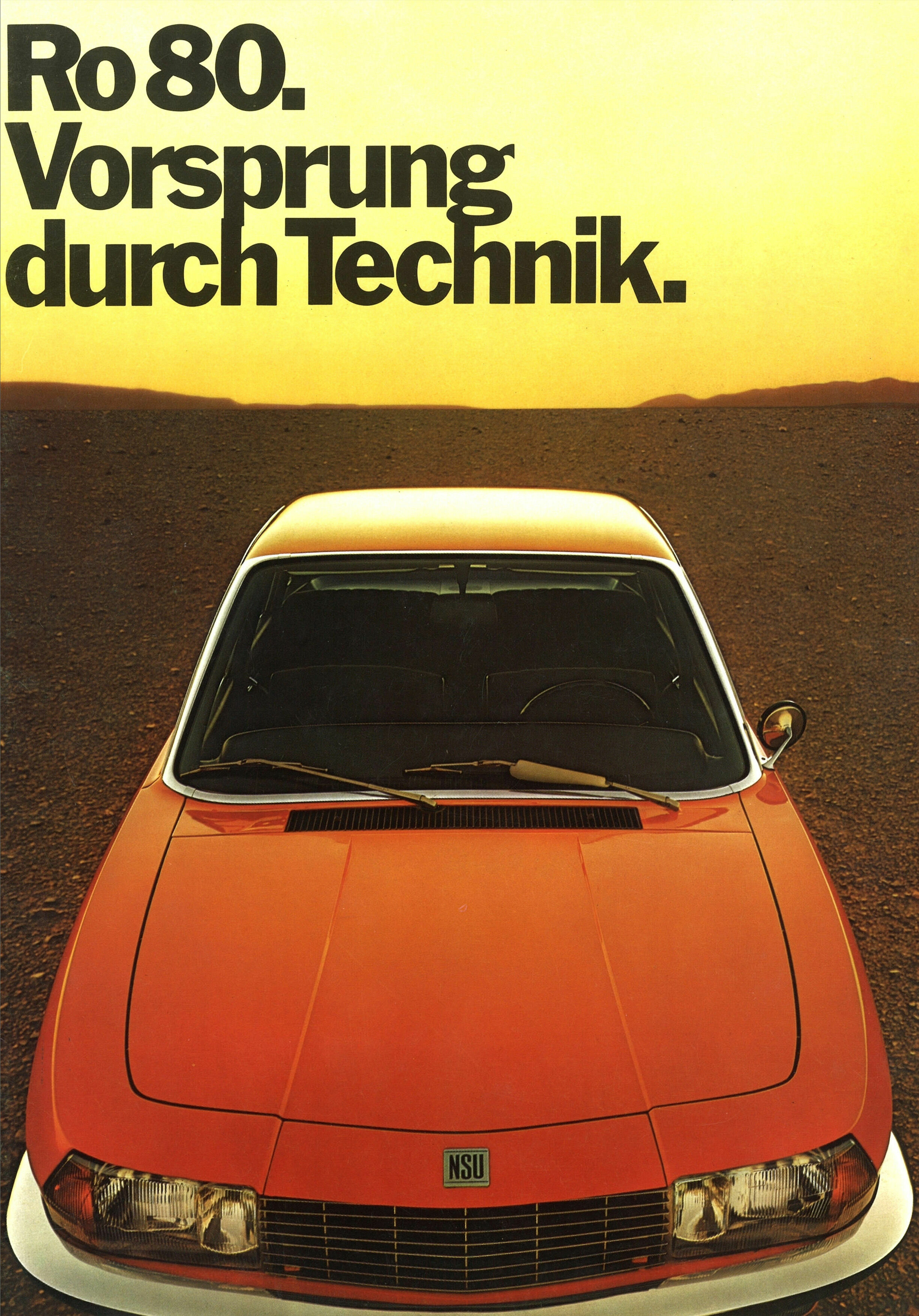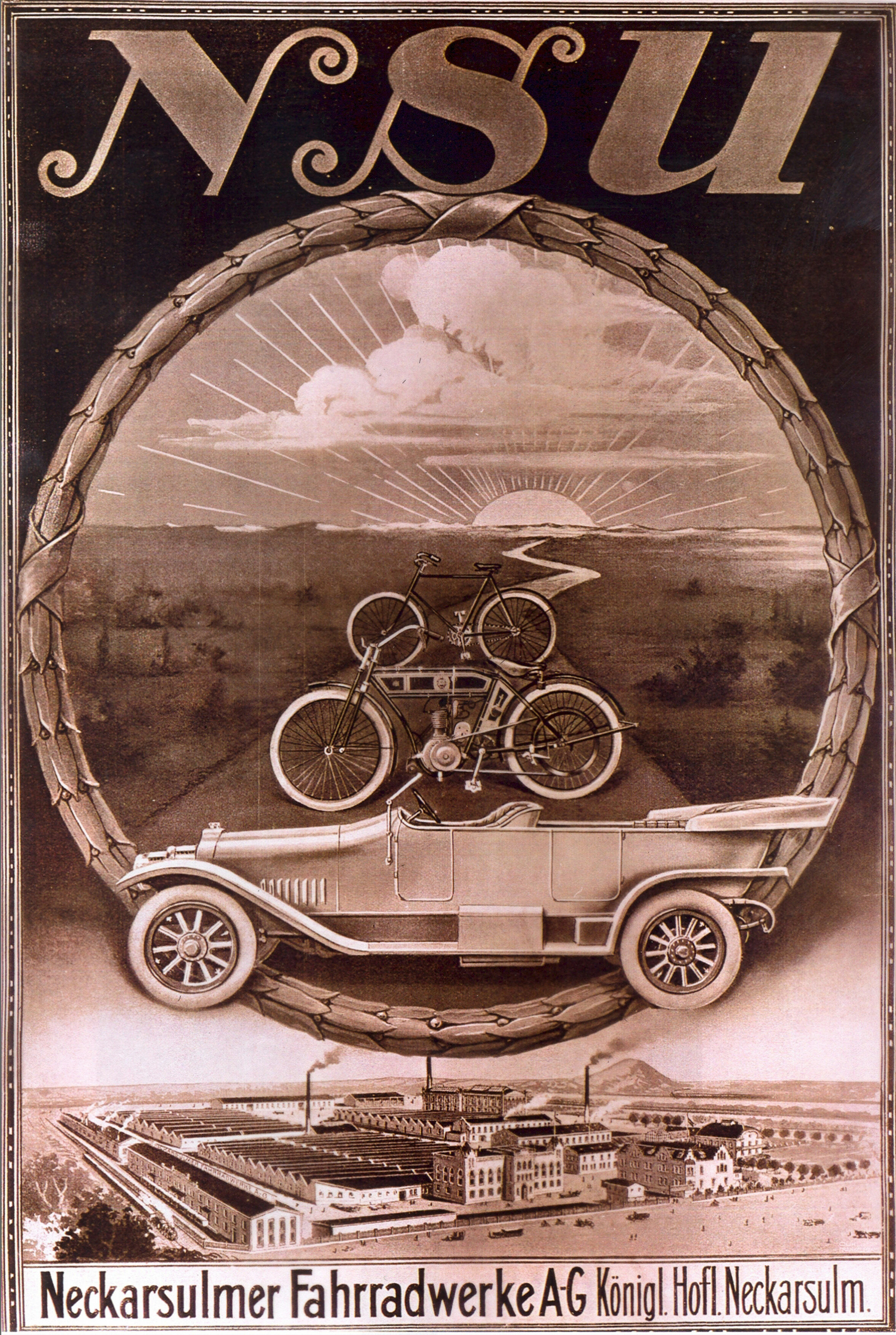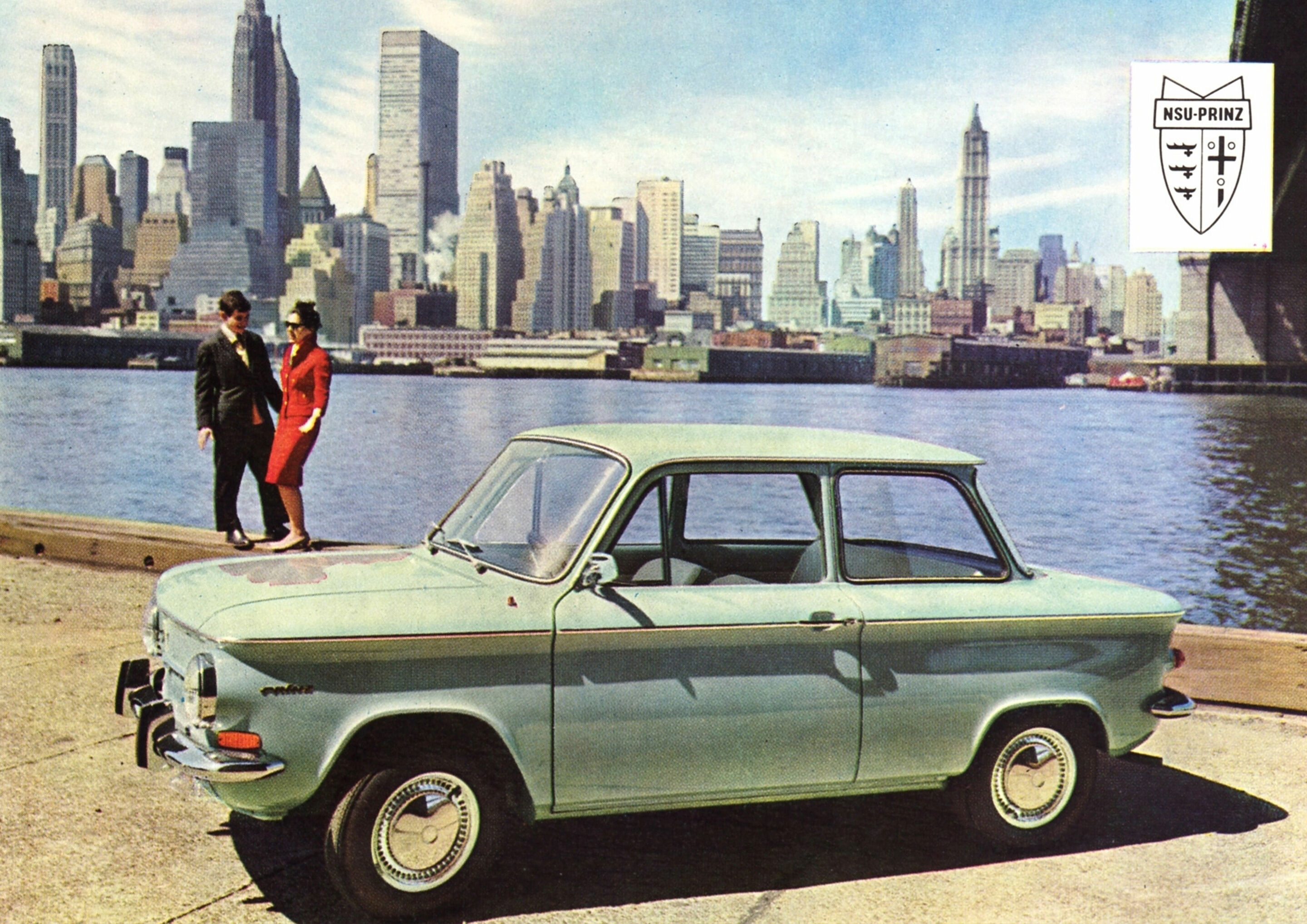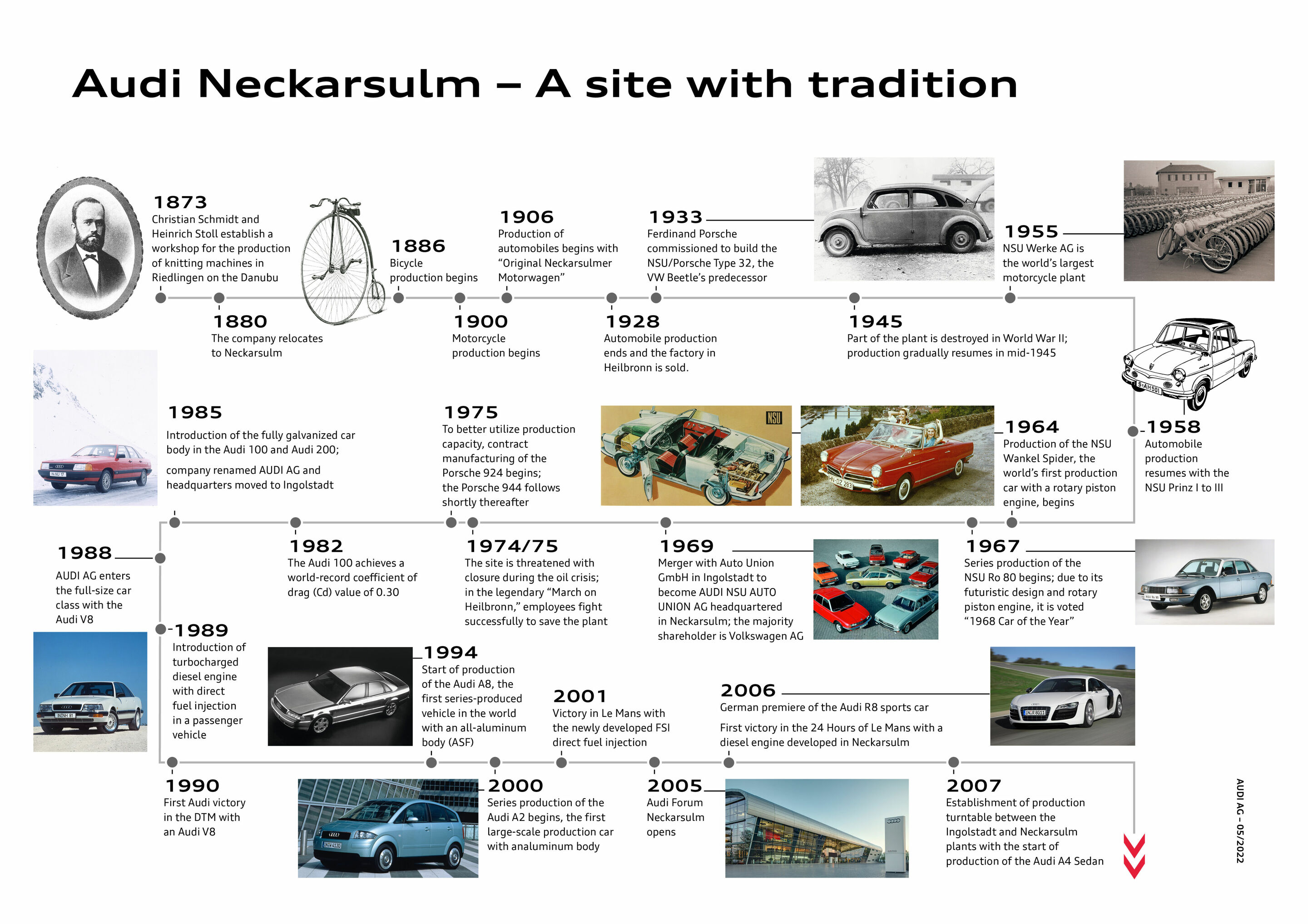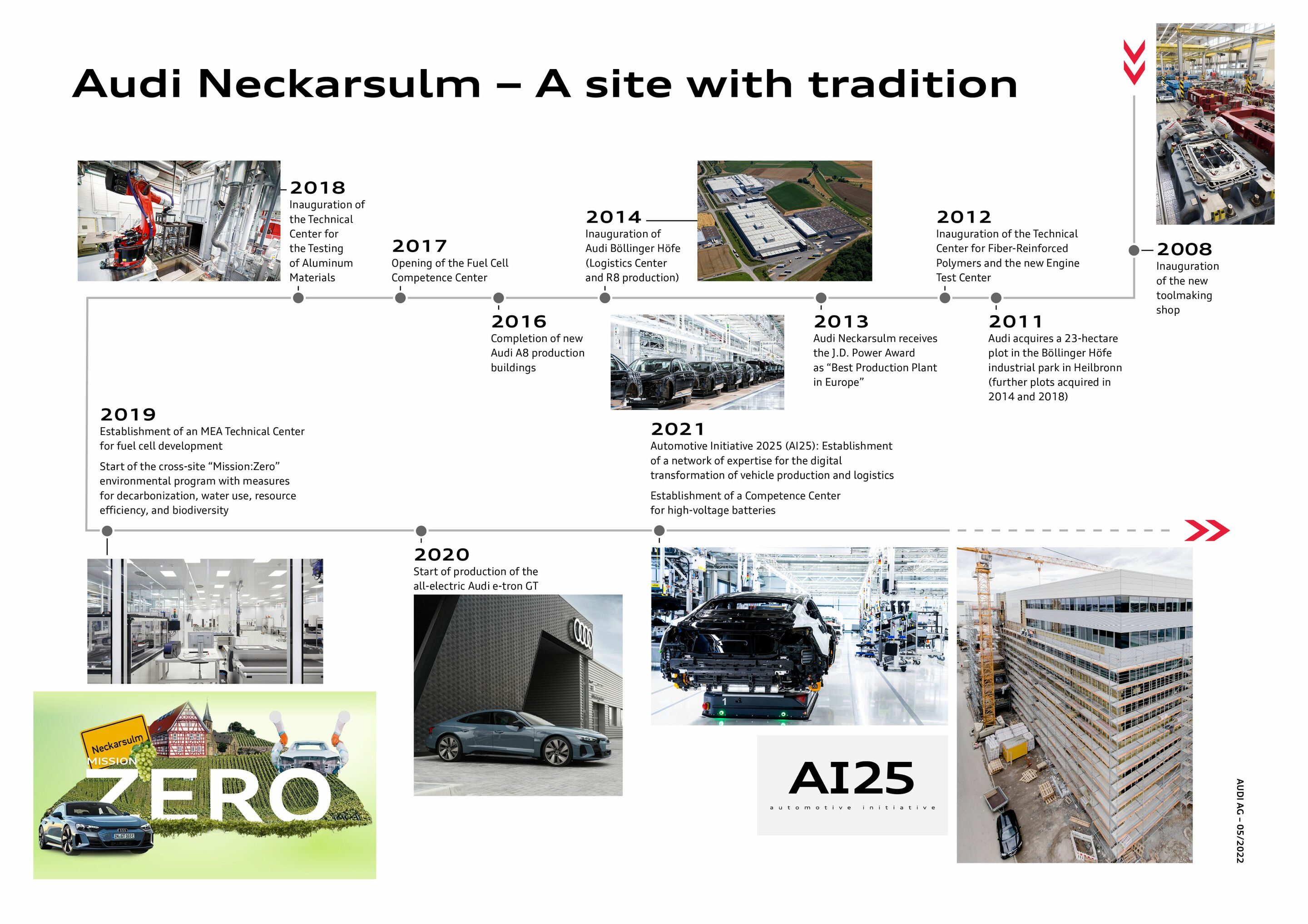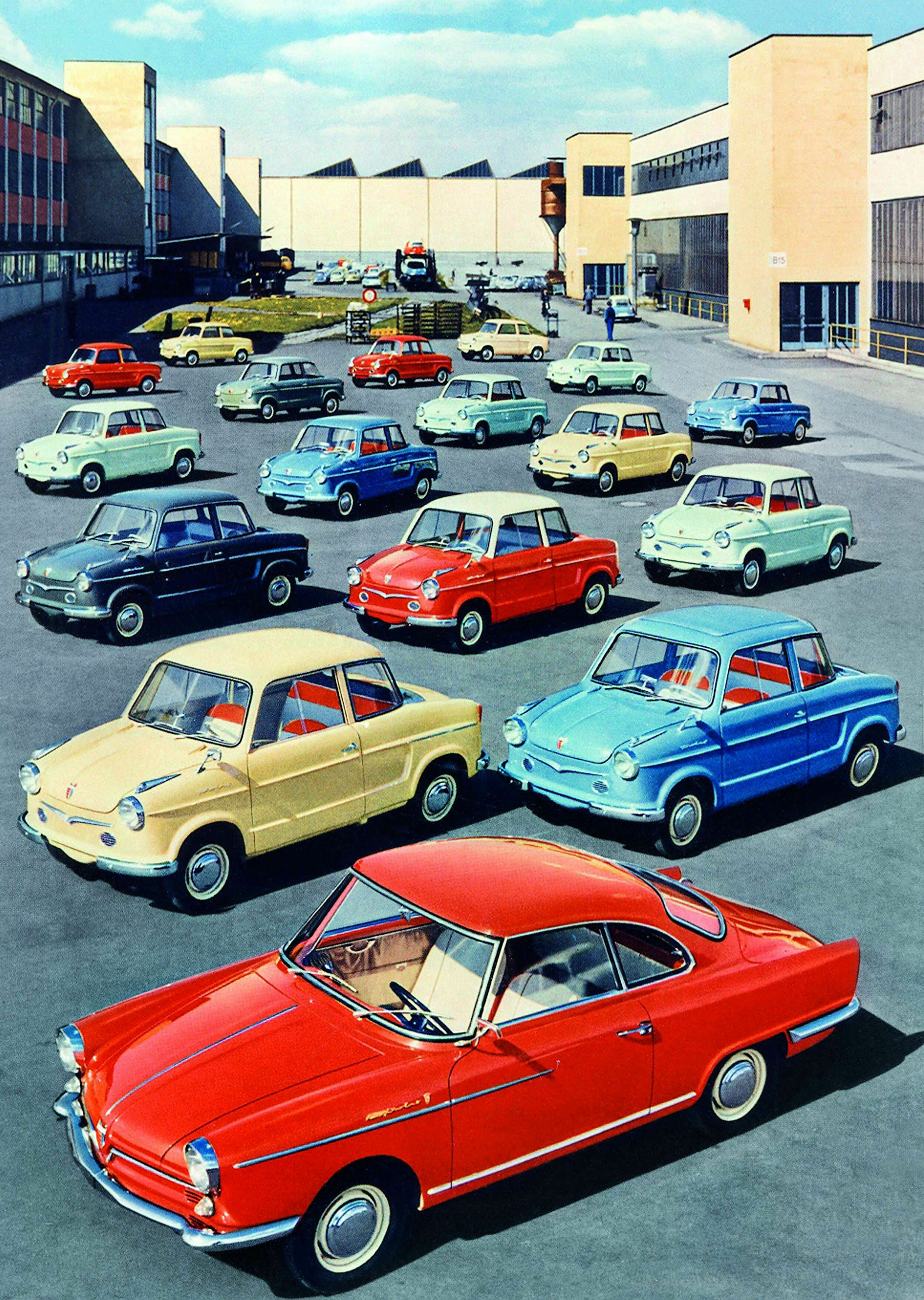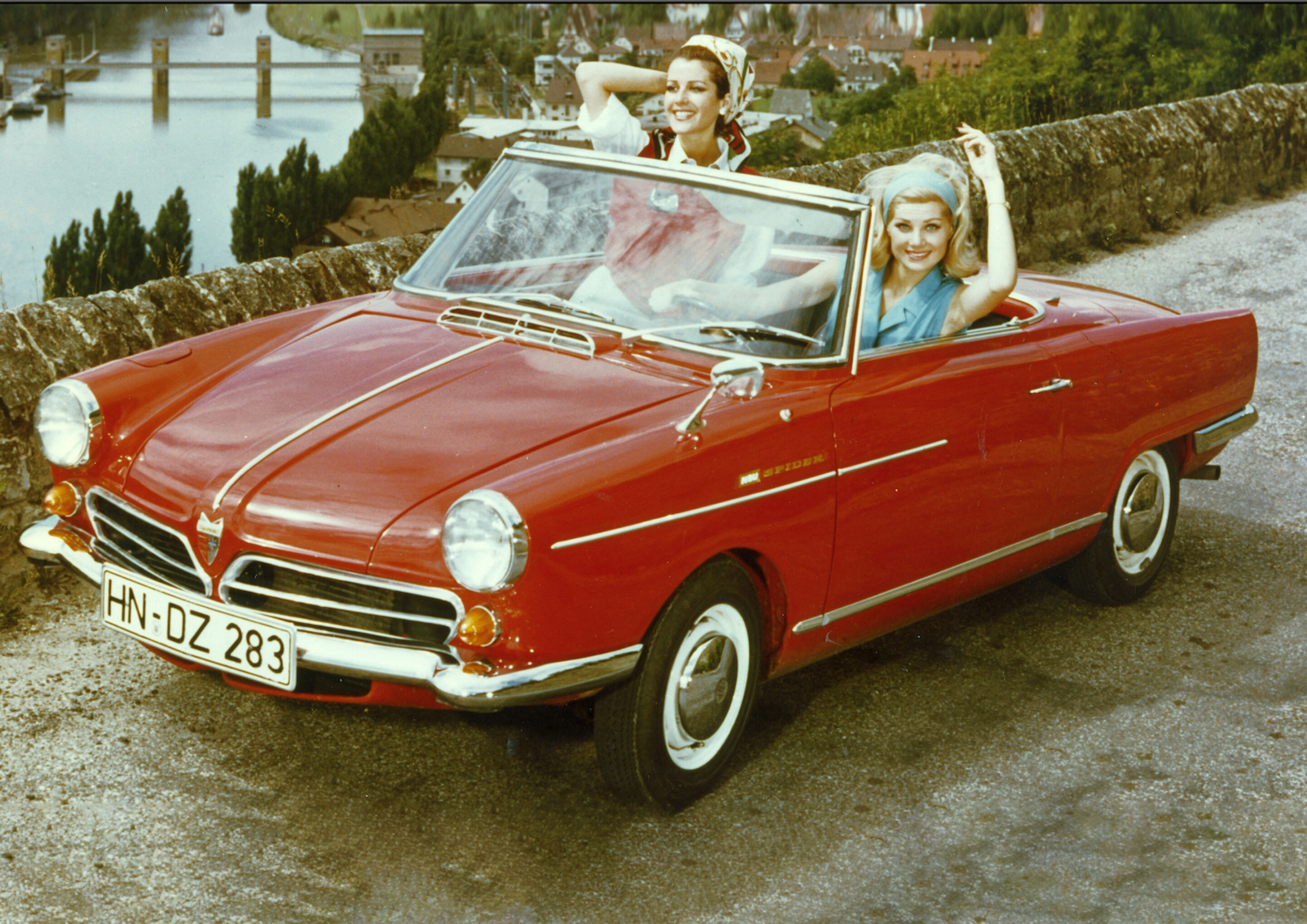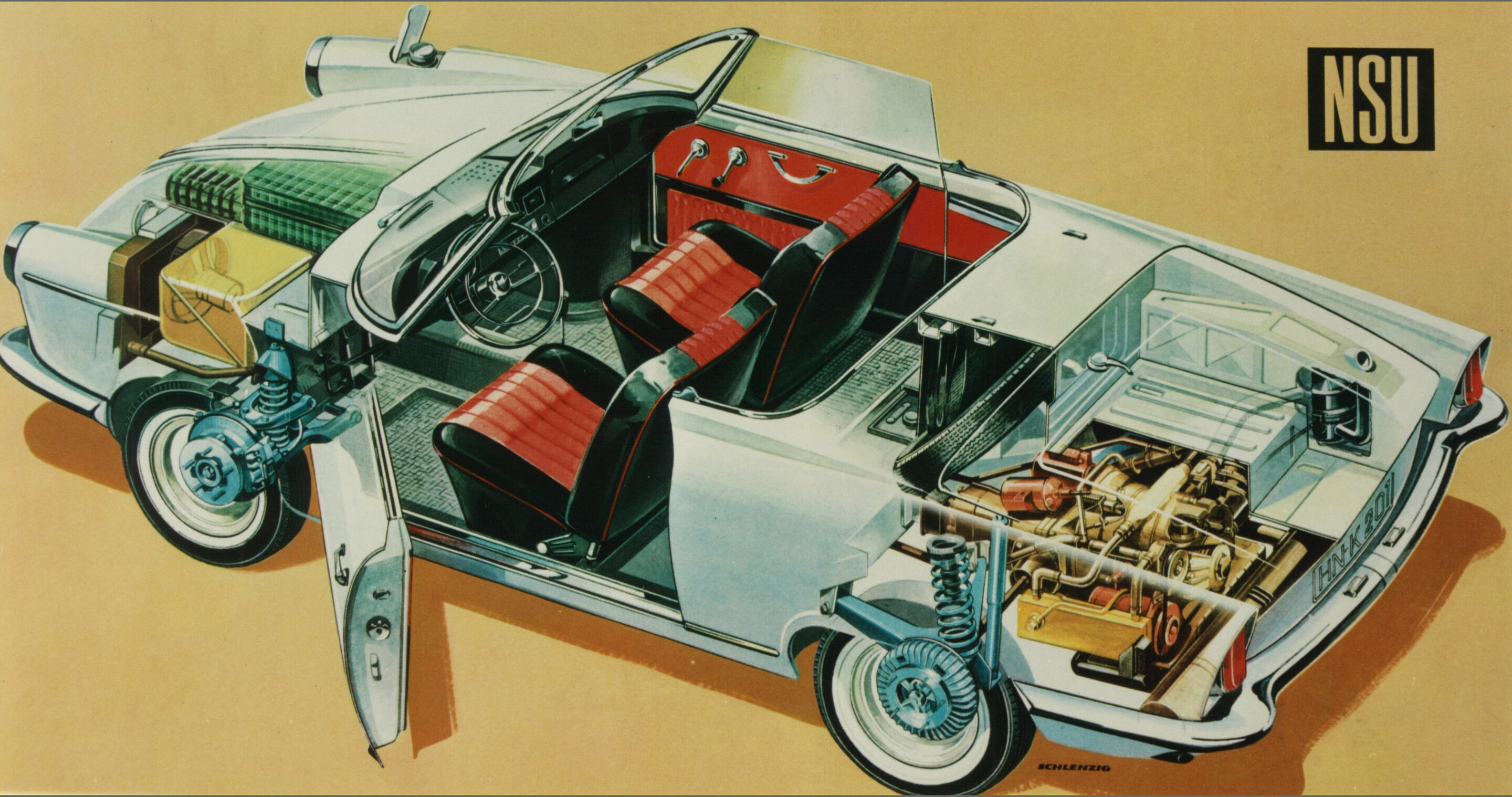The traditional NSU brand and the Audi Neckarsulm site: 150 years of innovation and transformation
- Roots of the traditional NSU brand go back to 1873.
- In the anniversary year of 2023, Audi Tradition will bring out a number of NSU highlights from AUDI AG’s historical vehicle collection for events.
- Ten-part series with classic and exotic cars from NSU’s product history
The traditional NSU brand is celebrating its birthday. In 1873, Christian Schmidt and Heinrich Stoll founded “Mechanische Werkstätte Schmidt & Stoll” in Riedlingen for the production of knitting machines, which later evolved into NSU Motorenwerke AG and ultimately into today’s Audi site in Neckarsulm. Even NSU’s name is closely associated with Neckarsulm, as the company name is derived from the city on the Neckar and Sulm rivers. NSU impressively demonstrates the development of mobility – from bicycles and motorcycles to automobiles. For its 150th anniversary, Audi Tradition is bringing out a number of NSU highlights from its historical vehicle collection. The special exhibition “Innovation, audacity and transformation”, a cooperation project between Audi Tradition and the German Bicycle and NSU Museum (Deutsches Zweirad- und NSU-Museum), is also under construction. The exhibition will be on display at the Audi Forum in Neckarsulm and at the German Bicycle and NSU Museum in Neckarsulm starting on June 14.
“There are so many stories to tell from the long history of NSU,” said Tobias Fräbel, an employee at Audi Tradition responsible for the corporate archives of the Neckarsulm site and the NSU brand. “Since we can’t tell all the stories in just one text, Audi Tradition will offer stories and background information about the company, its products, its involvement in racing and much more throughout the year.” These posts can be found on Audi Tradition’s Instagram channel and in the Audi MediaCenter. There, Audi Tradition will launch a ten-part series. From March to December, one NSU model will be introduced every month – from the brand’s classics, whether they have two or four wheels, to prototypes and exotic models. If that’s not enough for you, you can naturally delve even deeper into the moving, multifaceted history of the traditional brand – for instance, through Klaus Arth’s Audi Tradition book “NSU-Automobile. Typen – Technik – Modelle”, published by Delius Klasing, or Peter Schneider’s book “Die NSU-Story”, published by Motorbuch-Verlag.
Fast-forward: The history of the traditional NSU brand
Founded in Riedlingen in 1873 by Christian Schmidt and Heinrich Stoll as a manufacturer of knitting machines, the company relocated to Neckarsulm in 1880, where it was converted into a joint-stock company in 1884. In 1886, the Neckarsulm company struck at the right time. Bicycles were becoming more and more popular, and NSU started producing and selling more and more of them from then on. Starting in 1900, the company began manufacturing motorcycles as well. The new brand name of N.S.U. (from NeckarSUlm) was suddenly becoming popular all over the world. In 1906, the first Original Neckarsulmer Motorwagen – a small mid-range car with a water-cooled four-cylinder engine – was introduced to the public. In 1909, 1,000 employees manufactured 450 automobiles. The Neckarsulm-based car maker first made automotive history with regard to lightweight construction in 1914, when Neckarsulm engineers built the NSU 8/24 PS with an aluminum body.
Despite the First World War and subsequent devaluation in the hyperinflationary year of 1923, NSU initially continued to do well financially. In 1923, 4,070 employees produced one car every two hours, one motorcycle every 20 minutes and one bicycle every five minutes. In 1924, the company invested in a new plant for automobile construction in Heilbronn in order to gain more space. Two years later, however, sales declined for the first time, which resulted in money problems. In 1929, NSU was forced to cease its automobile production and sell the nearly new plant in Heilbronn to Fiat. Fiat built cars there under the name NSU-Fiat until 1966. From then on, Neckarsulm focused on the production of two-wheelers, took over a majority of Wanderer’s motorcycle division in 1929 and established a sales cooperation with the brand D-Rad in Berlin in 1932. Alongside BMW and DKW, NSU was one of the most important German motorcycle brands in the 1930s. After it took over Opel’s bicycle production at the end of 1936, it became one of the largest manufacturers of two-wheelers in Germany. In 1933/34, NSU built three prototypes of a vehicle designed by Ferdinand Porsche with an air-cooled 1.5-liter boxer engine in the rear. In its basic conception, this car was similar to the later VW Beetle. However, it was not mass produced due to financial reasons. By the end of the war in May 1945, large portions of the Neckarsulm plant facilities were in ruins.
Reconstruction after the Second World War followed with the popular NSU bicycles and the 98-cc NSU Quick moped. A 125- and 250-cc model were added soon after. Later came the NSU Fox, the NSU Lux, the NSU Max and the NSU Konsul, with 500 ccs of engine displacement. With an annual production of almost 300,000 motorized two-wheelers (mopeds, motorcycles and scooters), the Neckarsulm-based company shot to the top of the international motorcycle industry in 1955. It was the largest two-wheeler plant in the world. Despite all the NSU motorcycles’ successes, which brought the company worldwide fame with wins in five motorcycle world championships between 1953 and 1955 and numerous world speed records, the corporate management had to respond to declining motorcycle demand starting in the mid-1950s. With increasing prosperity, customers wanted to drive cars, so it was time for NSU to start producing automobiles again.
NSU managed to resume automobile construction in 1958 with the Prinz compact car. Technical innovations soon emerged. NSU had been working on a completely new engine concept with Felix Wankel since the beginning of the 1950s. In 1957, a Wankel-type rotary piston engine fired its ignition for the first time at an NSU testing station.
In 1963, the Neckarsulm-based company introduced the NSU Wankel Spider at the IAA in Frankfurt, thus writing automotive history. It was the world’s first series-production automobile powered by a single-rotor rotary engine, with 497 ccs and 50 hp. The next sensation followed in the fall of 1967, when the Neckarsulm-based company introduced the NSU Ro 80 at the IAA in Frankfurt, thrilling the automotive world. The car was powered by a dual-rotor NSU/Wankel rotary engine (115 hp), and its revolutionary design attracted a lot of attention. Also in 1967, the NSU Ro 80 became the first German automobile to be voted Car of the Year.
On March 10, 1969, a contract was signed to merge NSU Motorenwerke AG and the Ingolstadt-based Auto Union GmbH under the umbrella of the Volkswagen Group. With retroactive effect from January 1, 1969, AUDI NSU AUTO UNION AG was created with its headquarters in Neckarsulm, and Volkswagenwerk AG held a majority interest. The new company’s model range was greatly varied, even from a technical point of view. In addition to the NSU Prinz and
NSU Ro 80, the Audi 100 was also built at the Neckarsulm site from then on. However, the two NSU models were phased out in the 1970s – the Prinz in 1973, after 15 years, and the Ro 80 in 1977, after ten years. Finally, on January 1, 1985, AUDI NSU AUTO UNION AG was renamed AUDI AG, and the company’s headquarters were moved from Neckarsulm to Ingolstadt. The company and products have borne the same name ever since.
Transformation, constantly reinventing oneself and one’s products – this is part of the history of NSU and Audi’s Neckarsulm site. It has developed both rapidly and continually in recent decades. With its expertise in large- and small-scale production, the Neckarsulm plant currently ranks among the most complex in Europe, and it’s one of the locations with the greatest product diversity in the Volkswagen Group. The site is gradually evolving into a smart factory, and it’s preparing for electrification. It’s also the center of expertise in high-voltage batteries. In addition to the Audi A8 flagship, the Audi R8 super sports car and other models in the B, C and D series, the sporty RS models are developed and manufactured in Neckarsulm as well – and not without reason, as this is where Audi Sport GmbH is based. This company traces its lineage back to the founding of quattro GmbH in 1983, meaning it will celebrate its 40-year anniversary in 2023. Since the end of 2020, the first all-electric Audi model made in Germany is also manufactured here: the Audi e-tron GT quattro. With around 15,500 employees at the Neckarsulm site, AUDI AG is currently one of the biggest companies in the economic region of Heilbronn-Franken. Everything started 150 years ago with ten employees – what a history, what dynamism, what a development!
Exciting chapter in NSU advertising: Creative, innovative, groundbreaking
“Fixe Fahrer fahren Fox”, “Kluge Köpfe kaufen Konsul”, “Nicht mehr laufen – Quickly kaufen!” – a lot of NSU advertising slogans are legendary. In his book “Fahre Prinz und du bist König. Geschichten aus der NSU-Geschichte” (Drive Prinz and You’re a King: Stories from NSU’s History), NSU’s former head of advertising Arthur Westrup explains that NSU didn’t have a lot of money on hand in the 1950s, which made him and his team all the more creative. In addition to their catchy phrases, the marketing experts came up with special campaigns.
For instance, a special ad for the NSU Quickly appeared on the back of the BILD newspaper every Monday, sometimes addressing current issues. One ad after an international match between Germany and England read: “You see the beaten players heading home from Berlin, and all the strikers wanly groan, ‘Blessed is he who has a Quickly!’” Another big advertising hit came in the year 1971. “Ro 80. Vorsprung durch Technik.” was written in big letters on the advertising poster for the NSU Ro 80. The famous Audi slogan was thus created in NSU’s Advertising department. It would stick in people’s minds worldwide: “Vorsprung durch Technik.”
Active in racing: Neckarsulm brings home victories and records
NSU can look back on a long and successful history in motorsport – both before and after the Second World War. Here’s a small assortment: With the 500-cc NSU racing motorcycle, the English rider Tom Bullus won the Grand Prix of Germany for Motorcycles (Großen Preis von Deutschland für Motorräder) at the Nürburgring in 1930. After Bullus won numerous other races and the Grand Prix of Nations (Großen Preis der Nationen) in Monza in record time with the NSU 500 SSR, his motorcycle was talked about as the most successful German racing bike. Between 1931 and 1937, NSU won German championships 11 times and Swiss championships five times. The “Bullus”, as fans called the NSU 500 SSR, was also available as a street sport bike – although with less power.
In the 1950s, NSU once again brought home nonstop victories. In 1950, Heiner Fleischmann (on a supercharged 500-cc NSU racing bike) and Hermann Böhm with Karl Fuchs in his sidecar (on a 600-cc motorcycle) both became German champions in their respective classes. Starting in the 1951 season, superchargers were no longer allowed in motorcycle racing, but the supercharged NSU bikes lived on. With streamlined fairings optimized in a wind tunnel and extended chassis, Wilhelm Herz became the fastest man in the world on a two-wheeler in 1951 and 1956, at 290 and 339 km/h, respectively. Thanks to their resemblance to whales and dolphins, the NSU racing bikes were soon to be called Rennfox Typ Delphin and Rennmax Typ Blauwal – and they won nearly everything there was to win in motorcycle racing at the time. NSU’s wins at the Tourist Trophy (TT) in 1954 were legendary as well. The factory team on the Isle of Man included Werner Haas, H.P. Müller, Hans Baltisberger and Rupert Hollaus. Hollaus finished the race, considered the most dangerous motorcycle race in the world, as the winner in the 125-cc class. Haas, Hollaus, Armstrong and Müller took first through fourth place in the class up to 250 ccs.
NSU also consistently scored victories on four wheels. Here are a few highlights from several decades: In 1926, four supercharged NSU 6/60 PS race cars took a quadruple win at the Grand Prix of Germany for Sports Cars (Großen Preis von Deutschland für Sportwagen) at the AVUS in Berlin. In the 1960s and 70s, the NSU Prinz, the NSU Wankel Spider and the NSU TT put their technical skills to the test in touring car racing, thrilling millions of spectators at racetracks all over the world. And one little guy always came out on top: the NSU Prinz TT. With this model, a total of 29 national championships were won in Europe and North America, while Willi Bergmeister became the German hill-climb champion in 1974.
Overview of the most important milestones: The history of NSU and Audi’s Neckarsulm site
| 1873 | Christian Schmidt and Heinrich Stoll establish a factory to produce knitting machines in Riedlingen, on the Danube. |
| 1880 | The company relocates to Neckarsulm. |
| 1886 | Bicycle production begins. |
| 1900 | Motorcycle production begins |
| 1906 | Production of automobiles begins with the Original Neckarsulmer Motorwagen |
| 1928 | Independent automobile production ends and the factory in Heilbronn is sold. |
| 1933 | Ferdinand Porsche commissions the construction of the NSU/Porsche Type 32, the VW Beetle’s predecessor. |
| 1945 | The plant is partially destroyed in World War II; production gradually resumes starting in mid-1945. |
| 1955 | NSU Werke AG becomes the biggest producer of two-wheelers in the world. |
| 1958 | Automobile production resumes with the NSU Prinz I to III. |
| 1964 | Production begins on the NSU Wankel Spider convertible, the world’s first production car with a rotary piston engine. |
| 1967 | Series production of the NSU Ro 80 sedan begins, which is voted Car of the Year for its futuristic design and rotary piston engine. |
| 1969 | Merger with Auto Union GmbH Ingolstadt to become AUDI NSU AUTO UNION AG; the majority shareholder is Volkswagen AG. |
| 1974/75 | The site is threatened with closure during the oil crisis. In the legendary March on Heilbronn in April 1975, the employees successfully fight to save the plant. |
| 1975 | To better utilize production capacity, contract manufacturing of the Porsche 924 begins; the Porsche 944 follows shortly thereafter. |
| 1982 | The Audi 100, manufactured in Neckarsulm, achieves a world-record drag coefficient of 0.30. |
| 1985 | The fully galvanized car body is introduced in the Audi 100 and Audi 200. The company is renamed AUDI AG and the headquarters are relocated to Ingolstadt. |
| 1988 | AUDI AG enters the full-size car class with production of the Audi V8. |
| 1989 | Introduction of the turbocharged diesel engine with direct fuel injection in a passenger vehicle, developed in Neckarsulm. |
| 1994 | Production starts on the Audi A8, the first series-production vehicle in the world with a completely aluminum body (ASF: Audi Space Frame). |
| 2000 | Production begins on the Audi A2, the first aluminum large-volume production car. |
| 2001 | Victory in Le Mans with FSI direct fuel injection, newly developed in Neckarsulm. |
| 2005 | The Audi Forum in Neckarsulm opens. |
| 2006 | Start of the production of the Audi R8 super sports car; first victory in the 24 hours of Le Mans with a diesel engine developed in Neckarsulm. |
| 2007 | The first production turntable is established between the Ingolstadt and Neckarsulm plants with the start of production of the Audi A4 Sedan. |
| 2008 | The new Audi toolmaking shop is inaugurated. |
| 2011 | Audi acquires a 230,000-square-meter plot at the Böllinger Höfe industrial park in Heilbronn (more plots acquired in 2014 and 2018). |
| 2012 | The Technical Center for Fiber-Reinforced Polymers and the new Engine Test Center are inaugurated. |
| 2013 | Audi Neckarsulm receives the J.D. Power Award as Best Production Plant in Europe. |
| 2014 | The Logistics Center and R8 production are inaugurated at Audi’s Böllinger Höfe. |
| 2016 | New Audi A8 production buildings are constructed. |
| 2017 | The Fuel Cell Competence Center is opened. |
| 2018 | The Technical Center for the Testing of Aluminum Materials is inaugurated. |
| 2019 | An MEA Technical Center (functional layer systems) for fuel cell development is established; the cross-site Mission:Zero environmental program begins with measures for decarbonization, sustainable water use, resource efficiency and biodiversity. |
| 2020 | Production of the fully electric Audi e-tron GT quattro begins. |
| 2021 | Automotive Initiative 2025 (AI25): A network of expertise for the digital transformation of vehicle production and logistics is established; a competence center for high-voltage batteries is established. |
| 2022 | Production is optimized for electromobility, including modernization of existing buildings and the groundbreaking ceremony for the new paint shop. |
